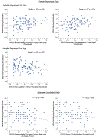Dimensions of interoception in obsessive-compulsive disorder
- PMID: 33194538
- PMCID: PMC7665060
- DOI: 10.1016/j.jocrd.2020.100584
Dimensions of interoception in obsessive-compulsive disorder
Abstract
Interoceptive sensibility (IS) refers to the subjective experience of perceiving and being aware of one's internal body sensations, and is typically evaluated using self-report questionnaires or confidence ratings. Here we evaluated IS in 81 patients with OCD and 76 controls using the Multidimensional Scale of Interoceptive Awareness (MAIA), which contains 8 subscales assessing adaptive and maladaptive responses to sensation. Compared to controls, OCD patients showed hyperawareness of body sensations. Patients also demonstrated a more maladaptive profile of IS characterized by greater distraction from and worry about unpleasant sensations, and reduced tendency to experience the body as safe and trustworthy. These findings were independent of medication status and comorbidities in the patient group. Correlational analyses showed that subscales of the MAIA were differentially associated with OCD symptom dimensions. These findings indicate that patients with OCD show abnormality of IS that is independent of confounding factors related to medication and comorbidities and associated with different OCD symptom dimensions. Future work would benefit from examining neural correlates of these effects and evaluating whether dimensions of IS are impacted by treatments for the disorder.
Figures



References
Grants and funding
LinkOut - more resources
Full Text Sources
